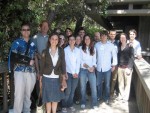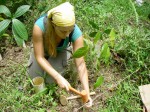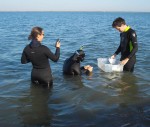The past year has been very busy for LTER graduate students. In May 2008, John Kominoski (formerly CWT) rotated out of his position as Graduate Student Committee co-chair and headed up north to the University of British Columbia as a post-doctoral research fellow. Chelse Prather (LUQ) took over John's role as co-chair alongside Amber Hardison (VCR). She came in with great energy and ideas to help improve the LTER graduate student experience and really hit the ground running! But we certainly miss working with John and thank him for his dedication to and leadership within the LTER network. Highlights of graduate student activities during the past year
John and Chelse co-hosted a graduate student mixer at the Ecological Society of America (ESA) annual meeting in Milwaukee, WI, in August 2008. Twelve graduate students and two postdocs attended the mixer where students learned about the LTER Network Office (LNO) and the services it provides, and also had opportunity to talk with graduate students from other sites. Please look for these mixers at ESA meetings every year.
Earlier, in June 2008, a survey was sent to the graduate students to gauge their satisfaction with and knowledge of LTER and LNO, and to solicit comments and suggestions for improvements. Of the 93 students who responded to the survey, 74 per cent said they were satisfied with their overall experience as LTER graduate students. In general, students could be divided into three categories:
- Those who were very happy with the LTER program
- Those who were happy with LTER but had little knowledge of LNO and/or did not utilize services provided by LNO
- Those who had no idea what was going on in the network.
We received a lot of helpful suggestions and will take them into account as we move forward with improving the LTER graduate student experience. We invite you to send any further comments or suggestions about LTER grad student activities to Amber (amber@vims.edu) or Chelse (cprather@nd.edu).
During the year, students made an outstanding effort to network across sites and outside the network. In May 2008, grad students from the California Current Ecosystem (CCE), Moorea Coral Reef (MCR), and Santa Barbara Coastal (SBC) LTER sites participated in the first University of California-LTER Graduate Student and Post-doc Symposium at the Scripps Institution of Oceanography. The event was organized by grad students Ryan Rykaczewski (CCE), Nichole Price (MCR), and faculty member Jenny Dugan (SBC). About 20 students and post-docs presented their work in a series of short talks and posters. The symposium was open to the public and was well attended by researchers not affiliated with LTER, giving participants the opportunity to share LTER-related research with other scientists.
Collaboration between the CCE, MCR, and SBC sites is natural, since each site focuses on marine ecosystems and has members based at the University of California (UC) schools in the Southern California region. The sites share several topics that are unique to long term research in the marine environment (e.g. population connectivity by advective and biological processes, flexibility in the size structure of primary producers and grazers, carbon flow through the marine ecosystem, close relationships between physical forcing and ecosystem structure). Rykaczewski noted that knowledge of the research conducted by other students at marine sites could facilitate future cooperation and discussion, and the students from each of the UC-based LTER sites plan to continue meeting to share their research experiences on an annual basis.
Similarly, students at the Central Arizona-Phoenix (CAP) LTER worked with faculty and administrators to organize an academic conference called "Dynamic Deserts: Resource Uncertainty in Arid Environments." The conference, co-sponsored by Arizona State University (ASU)'s School of Life Sciences, focused on a variety of ecological and social approaches to understanding how organisms, ecosystems, and human systems respond to both variability and uncertainty in arid environments. The student researchers discussed diverse topics, including bird and koala behavioral changes during heat waves in Australia, positive effects of Arizona's golf courses on the Gila monster physiology, changes in pinyon pine seed availability in pre-historic human settlements in the southwestern UnitedStates, and gerbil foraging dynamics under predation pressure and heat stress in Israel. The students formed four teams to develop synthetic papers that cut across the range of research methods, approaches, and perspectives to identify gaps in current research agendas. The group looks forward to working with senior researchers to develop manuscripts for a special section in Oecologia.
The CAP LTER and ASU grad students also used the workshop as a platform to develop interactions between the arts and sciences. Several CAP graduate students have been working to understand the ways in which the sciences and arts visualize pattern and process. Guided by CAP-affiliated faculty and staff, the students submitted a grant proposal to NSF's "Communicating Science to Public Audiences" program. If funded, the grant will be used to develop an exhibit of artistic and scientific interpretations of urban ecology that will be displayed to local audiences.
In the meantime, several innovative partnerships have started to take shape. A photographic narrative titled: "Deserted: Forgetting Nature, Humanity, and History in the Salt River Bed" has been accepted for the Millennium Conference of the Ecological Society of America in November. Other students have started to develop creative metaphorical parallels between fungal endophytes' relationships with their host and the social relationships among a group of women who work from home. Bethany Cutts, CAP grad student representative, finds these conversations fascinating. She observes that several students have acknowledged reconfiguring their way of thinking about their artistic/scientific work as a result of the questions and information offered through these alternative perspectives. For more information on either project, please visit http://sols.asu.edu/frontiers/2009/index.php.
These symposia are great examples of grad student meetings that reach beyond their LTER site. We encourage an annual meeting of students at each site or across sites to present research, share ideas, and facilitate interaction among students. Currently, we are planning the 3rd Graduate Student Symposium (GSS), to be held on Sunday, September 13, during the 2009 LTER All Scientists Meeting in Estes Park, CO. We encourage grad students to attend and to consider writing a proposal for a working group at this meeting. Working group proposals for the GSS are due July 1. We have recruited an energetic planning committee, which includes Jessica Savage (CDR), Kristen Schwarz (BES), Michelle Romolini (BES) and Luke Cole (VCR) and hope to see many of you in September. Please email us if you have any questions.
Amber Hardison and Chelse Prather are the Graduate Student Committee co-Chairs

 Enlarge this image
Enlarge this image

